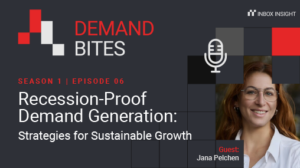Understanding your prospects’ buying behavior is crucial for sales and marketing success. That’s where B2B buyer intent data comes in – a game-changing tactic that has transformed the way businesses intercept, engage and convert new business.
According to our first-party research conducted within our IFP community, 99% of B2B marketers have witnessed significant sales and ROI increases by leveraging the power of intent data. The results speak for themselves…
In this guide we’ll explore the following:
- What is B2B intent data
- The different types of buyer intent
- The benefits of leveraging purchase intent data
- Intent data use cases
- Where to find B2B intent data
- Key features to look out for when choosing an intent data provider
What is B2B intent data?
B2B intent data is a dataset that signifies when a prospect is in-market, usually based on their digital behaviors. Through aggregating multiple intent data sources and analyzing against the buyer’s journey, it’s possible to gauge how sales ready a lead is, before sales make contact. This insight helps go-to-market teams prioritize specific groups of people based on their intent, ensuring resources are aligned to the most profitable opportunities.
The different types of buyer intent data
When it comes to intent data, two key components are essential: first party insights and third party information.
First party intent data
First party intent data is a valuable source of information with a high level of accuracy. By collecting behavioral data directly from your customers, you gain insights that are reliable and specifically tailored to your business. This data is acquired through various methods, including tracking tools like cookies and analytics, surveys, and customer feedback.
Here are some key indicators of buyer intent that can be collected from 1st party data:
- Website engagement: Analyzing metrics such as number of page views and click-through rates (CTRs) can provide valuable insights into the level of interest and engagement a prospect has with your website. For example, if a prospect repeatedly visits your pricing page, it indicates a higher level of intent to make a purchase.
- Content consumption: Monitoring which types of content your prospects engage with the most can reveal their interests, pain points, and intent. For instance, if a prospect consistently downloads whitepapers or attends webinars on a specific topic, it suggests a strong intent to educate themselves further and potentially move forward in the sales funnel.
- Form submissions: Tracking form submissions, such as demo requests, contact inquiries, or content downloads, provides valuable data on prospects actively seeking more information about your products or services. These actions indicate a higher level of interest and intent to engage with your business.
Third party intent data
Third party intent data plays a crucial role in understanding buyer intent in B2B sales. This data is collected from external sources across the internet and provides valuable insights into a customer’s online behavior, including their search activities, website visits, purchases, and more.
To obtain this data, businesses employ various methods, such as reverse IP lookup, bidstream data, media exchange platforms, publishers and strategic partnerships. These methods allow them to access a wealth of information about potential buyers, which is then compiled into a comprehensive database.
Here are some indicators of buyer intent that can be derived from 3rd party intent data:
- Review platform engagement: Examining prospects’ engagement with review platforms like G2 or Capterra offers valuable insights into their intent. Monitoring activities such as reading reviews, comparing products, or asking questions on these platforms indicates a proactive interest in evaluating potential solutions and understanding user experiences.
- Topic and keyword analysis: By analyzing the keywords and topics that prospects are searching for, businesses can gain valuable insights into their purchasing intent. For example, consistent searches for terms related to a specific product or solution indicate a strong intent to explore or potentially make a purchase in that area.
- Content Hubs: Third party publishing platforms or content hubs that enable users to self-serve a wide variety of content on specific categories provides opportunities to gather a variety of intent signals such topic surges and engagement metrics like page duration and number of content downloads. This provide useful insight into how far along the research phase a prospect is.
- Purchase signals: Observing prospects’ online purchase behavior provides clear indications of their intent to buy. Tracking data on online purchases or transactions related to specific products or services allows businesses to identify prospects who are actively considering a purchase in the near future.
Primary sources of intent signals
In addition to these categories, businesses can harness four primary sources of intent signals for their marketing and sales efforts:
- Search intent data: This is generated when potential customers use search engines like Google to look up keywords or phrases. It helps businesses identify their target audience’s interests and needs more effectively.
- Engagement data: Engagement data refers to the interaction of prospective buyers with specific pieces of content. This includes activities like reading, sharing, or commenting on content across various channels, such as blogs, websites, and social media platforms. Leveraging engagement data allows businesses to gauge customer interest and tailor their strategies accordingly.
- Firmographic data: Firmographic relates to the information about a prospective company. It includes details like the company size, location, industry, and revenue, which can be sourced from business directories, website forms, and B2B data providers. Utilizing firmographic data provides insights into the characteristics and needs of target companies, enabling more personalized and targeted marketing efforts.
- Technographic data: Technographic data encompasses details about the business software, hardware, and networks a company uses. This type of data can be collected through surveys, questionnaires, and polls to gain a deeper understanding of a target company’s technical capabilities and needs. Leveraging technographic data helps businesses align their offerings with the technological requirements of prospective customers, optimizing their sales strategies.
The benefits of intent data for marketing and sales strategies
Intent data has emerged as a more targeted approach to understanding potential customers’ needs through their search behavior. This allows for more tailored sales strategies to be developed.
By utilizing intent data, businesses are better equipped to align their marketing and sales teams with customer behavior, enhancing efficiency, and significantly accelerating the sales process. This alignment results in higher conversion rates, ultimately leading to business growth.
Here are 5 benefits of B2B intent data:
- Helps businesses identify target audience interests and needs more effectively
- Allows businesses to gauge customer interest and tailor strategies accordingly
- Provides insights into the characteristics and needs of target companies for personalized marketing efforts
- Aligns offerings with the technological requirements of prospective customers, optimizing sales strategies
- Enhances lead generation and conversion by understanding buyer intent and behavior
Intent data use cases: 10 Practical applications in B2B
B2B intent data offers numerous opportunities to enhance marketing and sales strategies. Let’s explore some practical use cases:
1. Eliminating uninterested buyers and boosting conversion rates
Intent data eliminates the risk of engaging with uninterested buyers. By streamlining your prospecting pipeline to qualified leads only, you dramatically increase conversion rate potential, giving your sales and marketing team a considerable advantage over competitors. Having a steady stream of leads with high purchase intent also helps to build predictable pipeline with a high sales velocity.
2. Capturing interest throughout the buyer journey
With buyer intent data, you can engage with customers before they reach out, tailor messaging based on their average content consumption, and build relationships with leads immediately. This approach allows you to capture interest throughout the buyer journey and create a more personalized buying experience.
3. Elevating Account-Based Marketing
To achieve successful Account-Based Marketing (ABM), it is crucial to precisely target accounts that align with your company’s offerings and represent high value opportunities. By incorporating intent data into your ABM strategy, you can effectively align your sales and marketing teams by prioritizing accounts based on buying signals such as account surge.
This strategic use of intent data enables you to focus your resources on the accounts that are most likely to convert, improving the efficiency and effectiveness of your ABM campaigns. Together, these efforts contribute to the overall success of your ABM strategy, driving growth and maximizing results.
4. Refining your targeting
Intent data increases accuracy and efficiency when organizing accounts into target segments. A data-driven targeting strategy allows for refining campaigns and improving relevancy through better personalization tactics. By utilizing firmographic and technographic intent, you can define criteria for constructing an ideal customer profile (ICP) and segment your ICP into priority tiers based on factors like readiness to buy and familiarity with your brand.
5. Enhancing ad campaigns
Intent data provides valuable context by revealing the topics and interests that resonate with individuals. Armed with this knowledge, you can develop targeted ad campaigns and distribute relevant, compelling content to address your prospects’ inquiries, increasing the effectiveness of your advertising efforts.
6. Scaling relevant content creation
Buyer intent data empowers your marketing teams to generate relevant content at scale. By segmenting accounts into ad groups and utilizing specific intent criteria, you can deliver personalized communications and tailor messaging based on various data points. This approach allows for more precise targeting, leading to increased engagement and improved conversion rates.
7. Enhancing ROI through precision retargeting
Leveraging buyer intent data increases the accuracy of your remarketing efforts, resulting in a higher return on investment (ROI). By retargeting top-tier target account lists exhibiting strong active buyer intent, you maximize the efficiency of your ad spend and ensure that your marketing budget focuses on engaging those most likely to take action.
8. Upselling and cross-selling opportunities
Intent data can reveal additional buying signals from your existing customer base. By monitoring their online activities and engagement with your content, you can identify upsell and cross-sell opportunities and proactively reach out to customers with relevant offers, contributing to revenue growth and increasing customer satisfaction.
9. Lead scoring and prioritization
Intent data is vital for effective lead scoring and prioritization in B2B sales. Modern lead prioritization approaches leverage advanced tech to process vast amounts of intent data. For example predictive analytics and machine learning are able identify which leads are most likely to convert and predict which accounts are the best fit for your business. While AI powered lead scoring accurately assigns scores based on behavior, interactions, and interest, allowing sales and marketing teams to prioritize their efforts and allocate resources efficiently.
10. Competitive intelligence
Another valuable use case for purchase intent data is competitive intelligence. By monitoring competitor mentions and activities in third party intent data sources, businesses can gain insights into market trends and competitive positioning. This competitive intelligence allows companies to stay ahead of the competition by understanding the strategies and tactics employed by their rivals. Armed with this information, businesses can make informed decisions and adjust their marketing and sales strategies accordingly, ensuring they remain competitive in the market.
Where to find B2B intent data?
According to our research, over half of marketers combine first party and third party data, and almost 40% of businesses are spending more than half of their marketing budget on intent data.
While ready-made applications can assist in gathering customer data from your website, if your objective is to obtain explicit purchase intent about your ideal B2B customer, opting for third-party intent may be a better choice.
Here are some reliable sources of intent data that you may consider for your B2B business:
- CRM System: One of the best sources of known first-party intent data is your CRM system. It tracks interactions and behavior of existing customers, giving you valuable insights into their interests and needs.
- Google Analytics: Google Analytics provides anonymous first-party data by tracking website visitors’ behavior and interactions. It offers insights into the pages they visit and how they engage with your content.
- Bombora: Bombora is a platform that aggregates information from a network of B2B websites to identify companies showing purchase intent signals. It offers known intent data as a third party source.
By utilizing these various sources, businesses can gain a deeper understanding of potential customers actively searching for solutions similar to theirs.
What key features to look out for when choosing an intent data provider?
The process of selecting a buyer intent data provider is critical to ensuring that the tools and insights you acquire are aligned with your business’s strategy, operational needs, and compliance requirements. This section provides a structured approach to gather requirements, prioritizing features, capabilities, and compliances essential for your specific needs and objectives.
- Define business objectives: Begin by explicitly defining your sales and marketing objectives. Are you looking to increase lead conversion rates, shorten sales cycles, or improve the precision of your targeting? Clear objectives will guide the selection criteria for a buyer intent data provider, ensuring alignment with your strategic goals.
- Identify essential features: Based on your objectives, list down the must-have features. This could include real-time data access, integration capabilities with your existing CRM and marketing automation platforms, the breadth of intent signals tracked, and the quality of data sources. Prioritize these features based on their direct impact on your objectives.
- Assess compliance needs: For B2B organizations, especially those operating across borders, compliance is non-negotiable. Determine your requirements for data privacy and security standards, including GDPR, CCPA, and any industry-specific regulations. Your chosen provider must demonstrate not only adherence to these regulations but also a commitment to data ethics.
- Evaluate data quality and sources: The accuracy and relevancy of buyer intent data are paramount. Investigate the provider’s data sources, the methodologies for data collection, and processing. Ask for case studies or references to understand the real-world effectiveness of their data in achieving sales and marketing goals.
- Analyze integration and support capabilities: Seamless integration with your existing tech stack avoids disruptions and facilitates efficient workflow. Additionally, assess the provider’s support services – from implementation to ongoing technical assistance. A provider with a commitment to support ensures that you maximize the value of your investment.
- Review scalability and flexibility: Your business needs will evolve, and so will your requirements for intent data. Consider the provider’s ability to scale and adapt to your changing needs. This includes expanding data coverage, integrating additional tools, and adjusting to new compliance landscapes.
- Request demonstrations and trials: Finally, witnessing the solution in action through demonstrations or trials will provide insights into usability and efficiency. This step is instrumental in evaluating whether the solution aligns with your expectations and operational workflows.
How Inbox Insight use intent data…
Inbox Insight uses market leading insight and AI lead prioritization to accelerate your demand generation results. Combining intelligence from first party data with third party intent scale, they help you gain a clear understanding of your market – then translate it into actionable insight. When activated into multichannel programs, these insights help capture, accelerate, and prioritize demand from the accounts you want to reach.
Demand Acceleration: Full-funnel marketing programs that drive pipeline growth
Demand Capture: Generate in-market leads from your ideal customer profile (ICP)
To run integrated programs that grab the attention of your target buyers, deliver high quality leads and improve the metrics that matter, speak with a specialist.
Key features:
- High-quality intent data powered by AI, leveraging DemandBI technology
- Powerful lead scoring capabilities, to analyze and understand buyer behavior in real-time
- Understand the key performance indicators (KPIs) on your campaign
- Prioritize leads to follow up
- Machine learning analyzes millions of job title combinations, which improves quality and accuracy of the leads generated.
Final thoughts
Buyer intent data has fundamentally changed the way prospecting is done. Being able to actively target an audience of decision makers to influence their buying decision is a cornerstone of modern intent-based marketing. As our first party research suggests, there is no doubt intent has hit the marketing mainstream, how marketers will continue to evolve and refine their practice will pave the way for future innovation.
Ready to reach in-market buyers through intent data?
See how Inbox Insight combine first party intent with third party scale to deliver precision led campaigns to relevant audiences displaying high intent. Learn more here.






